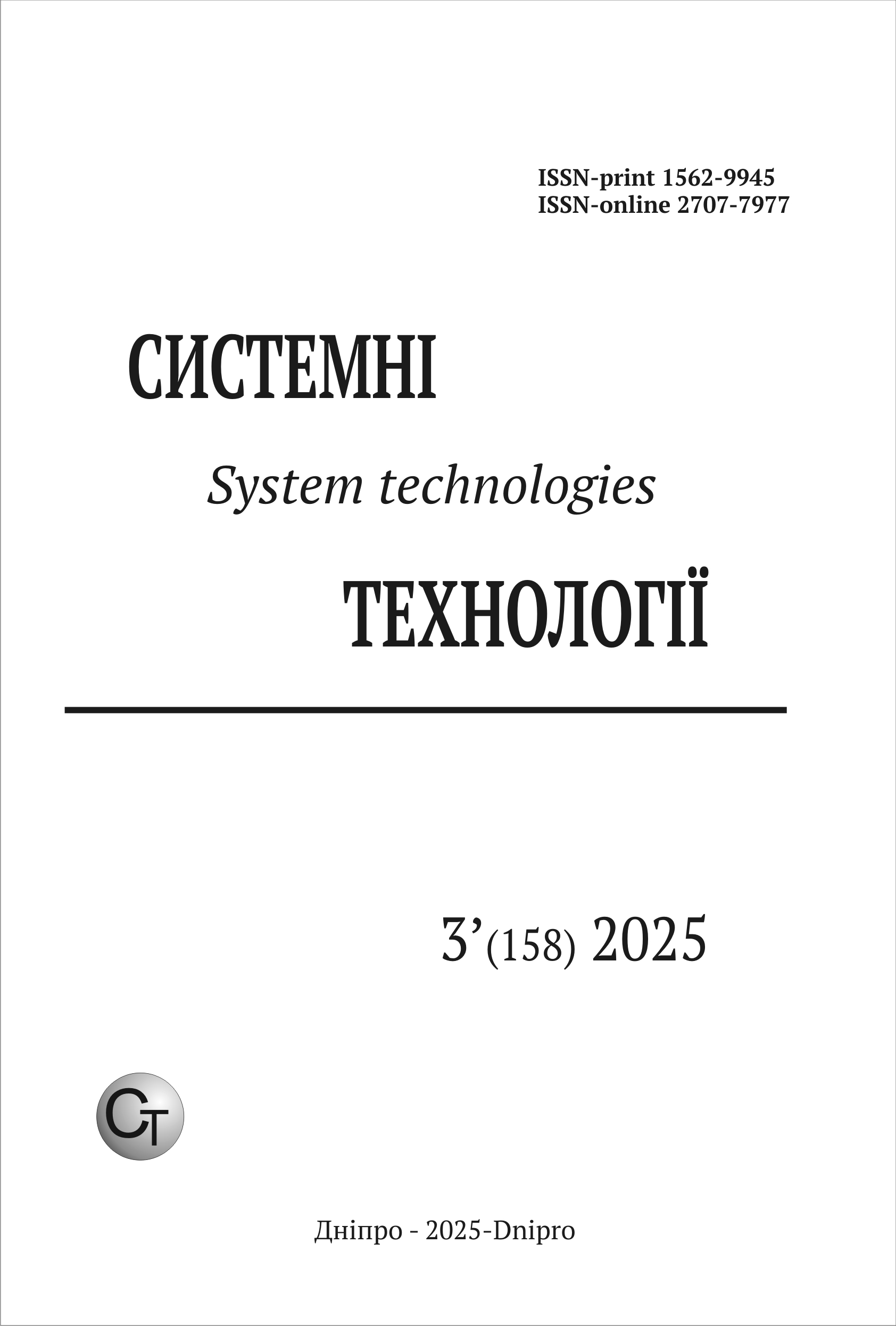System approach to forecasting electricity demand based on machine learning
DOI:
https://doi.org/10.34185/1562-9945-3-158-2025-05Keywords:
Forecasting, Electricity demand in Ukraine, Machine learning methods, Data processing, Methodology of forecasting, ARIMA, GAM, ANN, BSTSAbstract
The article explores a systemic approach to solving the problem of forecasting electric-ity demand in Ukraine based on machine learning methods. The sequence of data processing stages when solving the forecasting problem using machine learning methods is presented. The methodology for solving the forecasting problem on time series is considered. The fore-casting process consists of five stages. The first stage includes data collection, analysis and interpretation. The next stage includes data research and preparation procedures. The third stage - the modeling stage consists of three parts: preparation of a data set for modeling, se-lection and training of models and assessment of their quality. The fourth stage is the fore-casting stage and calculation of quality indicators of forecasts. At the fifth stage, procedures are performed to increase the efficiency of the selected forecasting model. At the modeling stage, the following models were used: ARIMA, GAM, ANN and BSTS. The models were ana-lyzed and forecasts were built based on each model. For the built models with the best quality indicators, forecast values were calculated. The forecasts were compared with the data of the validation sample. To select the optimal model, the following indicators were used: MAPE, MAE, MSE, RMSE. The BSTS model showed the best results.
References
M. R. Kazemzadeh, A. Amjadian, T. Amraee. A hybrid data mining driven algorithm for long term electric peak load and energy demand forecasting. Energy 2020, 204, 117948.
J. Hao, X. Sun, Q. Feng. A Novel Ensemble Approach for the Forecasting of Energy Demand Based on the Artificial Bee Colony Algorithm. Energies 2020, 13, 550.
J. del Real, F. Dorado, J. Durán. Energy Demand Forecasting Using Deep Learning: Applications for the French Grid. Energies 2020, 13, 2242.
J. Bedi, D. Toshniwal. Deep learning framework to forecast electricity demand. Appl. Energy 2019, 238, pp. 1312–1326.
F. Kaytez. A hybrid approach based on autoregressive integrated moving average and least-square support vector machine for long-term forecasting of net electricity consumption. Energy 2020, 197, 117200.
S. Di Leo, P. Caramuta, P. Curci, C. Cosmi. Regression analysis for energy demand projection: An application to TIMES-Basilicata and TIMES-Italy energy models. Energy 2020, 196, 117058.
P. Ramsami, R. T. A. King. Neural Network Frameworks for Electricity Forecasting in Mauritius and Rodrigues Islands. In Proceedings of the 2021 IEEE PES/IAS PowerAfrica, Nairobi, Kenya, 2021, pp. 1–5.
D. Angelopoulos, Y. Siskos, J. Psarras. Disaggregating time series on multiple criteria for robust forecasting: The case of long-term electricity demand in Greece. Eur. J. Oper. Res. 2019, 275, pp. 252–265.
U. Şahin, S. Ballı, Y. Chen. Forecasting seasonal electricity generation in European countries under COVID-19-induced lockdown using fractional grey prediction models and machine learning methods. Appl. Energy 2021, 302, 117540.
R. Hou, S. Li, M. Wu, G. Ren, W. Gao, M. Khayatnezhad. Assessing of impact climate parameters on the gap between hydropower supply and electricity demand by RCPs scenarios and optimized ANN by the improved Pathfinder (IPF) algorithm. Energy 2021, 237, 121621.
Baba. Advanced AI-based techniques to predict daily energy consumption: A case study. Expert Syst. Appl. 2021, 184, 115508.
M. Pegalajar, L.G. B. Ruíz, M. P. Cuéllar, R. Rueda. Analysis and enhanced prediction of the Spanish Electricity Network through Big Data and Machine Learning techniques. Int. J. Approx. Reason. 2021, 133, pp. 48–59.
N. M. M. Bendaoud, N. Farah, S. Ben Ahmed. Applying load profiles propagation to machine learning based electrical energy forecasting. Electr. Power Syst. Res. 2022, 203, 107635.
R. Porteiro, L. Hernández-Callejo, S. Nesmachnow. Electricity demand forecasting in industrial and residential facilities using ensemble machine learning. Rev. Fac. De Ing. 2022, 102, pp. 9–25.
Y. Lu, G. Wang. A load forecasting model based on support vector regression with whale optimization algorithm. Multimed. Tools Appl. 2023, 82, pp. 9939–9959.
S. Li, X. Kong, L. Yue, C. Liu, M. A. Khan, Z. Yang, H. Zhang. Short-Term Electrical Load Forecasting Using Hybrid Model of Manta Ray Foraging Optimization and Support Vector Regression. J. Clean. Prod. 2023, 388, 135856.
J. Huang, M. Algahtani, S. Kaewunruen. Energy Forecasting in a Public Building: A Benchmarking Analysis on Long Short-Term Memory (LSTM), Support Vector Regression (SVR), and Extreme Gradient Boosting (XGBoost) Networks. Appl. Sci. 2022, 12, 9788.
C. E. Velasquez, M. Zocatelli, F. B. Estanislau, V. F. Castro. Analysis of time series models for Brazilian electricity demand forecasting. Energy 2022, 247, 123483.
F. Pallonetto, C. Jin, E. Mangina. Forecast electricity demand in commercial building with machine learning models to enable demand response programs. Energy AI 2022, 7, 100121.
E. C. May, A. Bassam, L. J. Ricalde, M. E. Soberanis, O. Oubram, O. M. Tzuc, A. Y. Alanis, A. Livas-García. Global sensitivity analysis for a real-time electricity market forecast by a machine learning approach: A case study of Mexico. Int. J. Electr. Power Energy Syst. 2022, 135, 107505.
W. J. Niu, Z. K. Feng, S. S. Li, H. J. Wu, J. Y. Wang. Short-term electricity load time series prediction by machine learning model via feature selection and parameter optimization using hybrid cooperation search algorithm. Environ. Res. Lett. 2021, 16, 055032.
R. Luzia, L. Rubio, C. E. Velasquez. Sensitivity analysis for forecasting Brazilian electricity demand using artificial neural networks and hybrid models based on Autoregressive Integrated Moving Average. Energy 2023, 274, 127365.
Energy Map. URL: https://map.ua-energy.org/uk/resources/5a616fba-fbc9-4073-9532-9161592faca8/
P. Bidyuk, I. Kalinina, A. Gozhyj. An Approach to Identifying and Filling Data Gaps in Machine Learning Procedures. Lecture Notes on Data Engineering and Communications Technologies (Switzeland). 2022. Vol. 77, pp. 164-176.
R. J. Hyndman, G. Athanasopoulos. Forecasting: Principles and Practice 3rd ed. Edition. Publisher: OTexts. 2021, 442 p.
T. Aggarwal. Master the Power of Seasonal Decomposition of Time Series (STL): Unveiling the Essence of Time. 2023. URL: https://medium.com/@tushar_aggarwal/master-the-power-of-seasonal-decomposition-of-time-series-stl-unveiling-the-essence-of-time-26c19a910314
Kalinina., P. Bidyuk., A. Gozhyj, P. Malchenko. Combining Forecasts Based on Time Series Models in Machine Learning Tasks. CEUR-WS. 2023. Vol. 3426. Pp. 25-35. CEUR-WS.org/Vol-3426/paper2.pdf.
Kalinina, P. Bidyuk, A. Gozhyj. Construction of Forecast Models based on Bayesian Structural Time Series. International Scientific and Technical Conference on Computer Sciences and Information Technologies. CSIT_2022. 2022. Pp. 180-184. doi: 10.1109/CSIT56902.2022.10000484.
Downloads
Published
Issue
Section
License
Copyright (c) 2025 System technologies

This work is licensed under a Creative Commons Attribution 4.0 International License.















